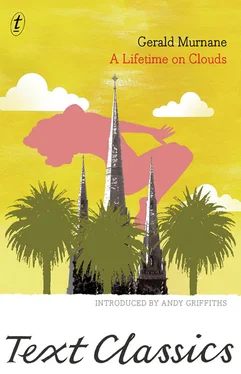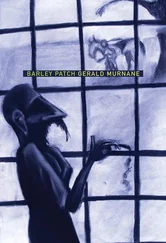Gerald Murnane - A Lifetime on Clouds
Здесь есть возможность читать онлайн «Gerald Murnane - A Lifetime on Clouds» весь текст электронной книги совершенно бесплатно (целиком полную версию без сокращений). В некоторых случаях можно слушать аудио, скачать через торрент в формате fb2 и присутствует краткое содержание. Год выпуска: 2013, Издательство: Text Classics, Жанр: Современная проза, на английском языке. Описание произведения, (предисловие) а так же отзывы посетителей доступны на портале библиотеки ЛибКат.
- Название:A Lifetime on Clouds
- Автор:
- Издательство:Text Classics
- Жанр:
- Год:2013
- ISBN:нет данных
- Рейтинг книги:3.5 / 5. Голосов: 2
-
Избранное:Добавить в избранное
- Отзывы:
-
Ваша оценка:
- 80
- 1
- 2
- 3
- 4
- 5
A Lifetime on Clouds: краткое содержание, описание и аннотация
Предлагаем к чтению аннотацию, описание, краткое содержание или предисловие (зависит от того, что написал сам автор книги «A Lifetime on Clouds»). Если вы не нашли необходимую информацию о книге — напишите в комментариях, мы постараемся отыскать её.
Earnest and isolated, tormented by his hormones and his religious devotion, Adrian dreams of elaborate orgies with American film stars, and of marrying his sweetheart and fathering eleven children by her. He even dreams a history of the world as a chronicle of sexual frustration.
A Lifetime on Clouds — читать онлайн бесплатно полную книгу (весь текст) целиком
Ниже представлен текст книги, разбитый по страницам. Система сохранения места последней прочитанной страницы, позволяет с удобством читать онлайн бесплатно книгу «A Lifetime on Clouds», без необходимости каждый раз заново искать на чём Вы остановились. Поставьте закладку, и сможете в любой момент перейти на страницу, на которой закончили чтение.
Интервал:
Закладка:
O’MULLANE: I would have backed myself with any money against bastards my own size.
CORNTHWAITE: The only cure is to get hold of a tart and do the real thing to her. O’Mullane will end up a homo the way he’s going. And Sherd will still be looking for a cure when he’s a dirty old bachelor.
After school each day Adrian Sherd walked from St Carthage’s College half a mile along the Swindon Road tramline to Swindon railway station. Then he travelled five miles by electric train to his own suburb of Accrington.
From the Accrington station Adrian walked nearly a mile along a dirt track beside the main road. It was 1953, and outer suburbs like Accrington had few made roads or footpaths. He passed factories whose names were familiar — PLASDIP PRODUCTS, WOBURN COMPONENTS, AUSTRALIAN CARD CLOTHING, EZIFOLD FURNITURE — but whose products were a mystery to him.
Adrian’s street, Riviera Grove, was a chain of waterholes between clumps of manuka and wattle scrub. Each winter, builders and delivery men drove their trucks over the low scrub, looking for a safe route, but the only people in the street who owned a car left it parked each night on the main road, two hundred yards from their house.
On one side of the Sherds’ house was a dense stand of tea-tree scrub thirty feet tall with only one narrow track winding into it. On the other side was the wooden frame of a house and behind it the fibro-cement bungalow, twenty feet by ten, where the New Australian Andy Horvath lived with his wife and small son and mother-in-law.
The Sherds’ house was a two-year-old double-fronted weatherboard, painted cream with dark green trimmings. It had a lawn with borders of geraniums and pelargoniums at the front, but the backyard was nearly all native grass and watsonia lilies. Along the back fence was a fowl-run with a shed of palings at one end. Near one of the side fences was a weatherboard lavatory (cream with a dark green door) with a trapdoor at the back where the night-man dragged out the pan each week and shoved an empty pan in. Sometimes the pan filled up a few days before the night-man’s visit. Then Adrian’s father would dig a deep hole in the fowl-run and empty half the pan into it. He did it furtively after dark while Adrian held a torch for him.
On the opposite side of the yard was a fibro-cement shed with a cement floor and a small louvre window at one end. One half of the shed was filled with bags of fowl-feed, garden tools and odd pieces of broken furniture. The other half was left clear. Leaning against one wall of the shed was a plywood door left over after the Sherds’ house had been built. A model railway layout was screwed onto one side of the door. It was a Hornby clockwork layout — a main track with a loop and two sidings.
The Sherds’ house had three bedrooms, a lounge, a kitchen, a bathroom and a laundry. The kitchen floor was covered with linoleum. All the other floors were polished boards. The lounge-room had an open fireplace, two armchairs and a couch of faded floral-patterned velvet, and a small bookcase. The kitchen had a wood stove and a small electric cooker with a hotplate and a griller. There was an ice-chest in a corner and a mantel radio over the fireplace. The table and chairs were wooden.
The only other pieces of furniture were the beds and wardrobes and dressing-tables — a walnut veneer suite in the front bedroom and oddments in the boys’ rooms. Adrian’s two younger brothers slept in the middle bedroom. Adrian had the back bedroom, which was called the sleepout because it had louvre windows.
As soon as Adrian got home from school he had to take off his school suit to save it from wear. Then he put on the only other clothes he had — the shirt and trousers and jumper that had been his previous school uniform but were now too patched for school.
Adrian’s young brothers had been home from school for an hour already. (They travelled a mile and a half by bus to Our Lady of Good Counsel’s parish school.) Adrian found and cleaned their school shoes as well as his own. He filled the wood-box in the kitchen with split logs that his father had left under a sheet of corrugated iron behind the lavatory. He filled a cardboard box in the laundry with briquettes for the hot-water system. Then he split kindling wood and stacked it on the kitchen hearth for his mother to use next morning. If his father was still not home, Adrian fed the fowls and collected the eggs.
Sometimes before tea Adrian climbed over the side fence and looked around in the tea-tree scrub. He visited a bull-ants’ nest and tapped a stick near the entrance. The ants came storming out to look for the enemy. Adrian dropped leaves and twigs on them to tease them.
There were possums’ nests high up in the branches of the tea-tree. Adrian knew the possums were hiding inside, but he had never been able to scare them out. The tea-tree had no branches strong enough for climbing, and the sticks that he threw got tangled in the twigs and foliage.
When Adrian had first discovered the ants and possums he decided to observe their habits like a scientist. For a few days he kept a diary describing the ants’ habits and drew maps to show how far they travelled from their nest. He thought of becoming a famous naturalist and talking on the radio like Crosbie Morrison with his program, Wild Life. He even planned to dig away the side of the ants’ nest and put a sheet of glass inside so he could study them in their tunnels. But he didn’t know where to buy glass and he found he couldn’t dig a hole with straight sides anyway.
If he walked on through the scrub he came to the Gaffneys’ side fence. The Sherds knew very little about the few other households in Riviera Grove. They were all what Adrian’s parents called young couples, with two or three small children. Adrian sometimes saw a mother in gumboots pushing a load of kids in a pram through the muddy street or chasing a child that had waded too far into a puddle. One day he had spied on Mrs Gaffney through a hole in her fence. She was wearing something that he knew was called a playsuit and hanging out nappies on the line. He had a good view of her face and legs but he decided it was useless to compare her with any film star or pin-up girl.
After he had set the table for tea, Adrian read the sporting pages of the Argus and then glanced through the front pages for the cheesecake picture that was always somewhere among the important news. It was usually a photograph of a young woman in bathers leaning far forward and smiling at the camera.
If the woman was an American film star he studied her carefully. He was always looking for photogenic starlets to play small roles in his American adventures.
If she was only a young Australian woman he read the caption (‘Attractive Julie Starr found Melbourne’s autumn sunshine yesterday too tempting to resist. The breeze was chilly but Julie, a telephonist aged 18, braved the shallows at Elwood in her lunch hour and brought back memories of summer.’) and spent a few minutes trying to work out the size and shape of her breasts. Then he folded up the paper and forgot about her. He wanted no Melbourne typists and telephonists on his American journeys. He would feel uncomfortable if he saw on the train one morning some woman who had shared his American secrets only the night before.
When tea was over Adrian stacked up the dishes and washed them for his brothers to dry and put away. At six-thirty he turned on the wireless to 3KZ. For half an hour while he finished the dishes or played Ludo or Snakes and Ladders with his brothers, he heard the latest hit tunes, interrupted only by brief advertisements for films showing at Hoyts Suburban Theatres.
Adrian always made a show of being busy at something else while hit tunes were playing. If his parents had thought he was listening to the words they might have switched the wireless off or even banned him from hearing the program again. Too many of the hit tunes were love songs about kisses like wine or memories of charms or touches that thrilled.
Читать дальшеИнтервал:
Закладка:
Похожие книги на «A Lifetime on Clouds»
Представляем Вашему вниманию похожие книги на «A Lifetime on Clouds» списком для выбора. Мы отобрали схожую по названию и смыслу литературу в надежде предоставить читателям больше вариантов отыскать новые, интересные, ещё непрочитанные произведения.
Обсуждение, отзывы о книге «A Lifetime on Clouds» и просто собственные мнения читателей. Оставьте ваши комментарии, напишите, что Вы думаете о произведении, его смысле или главных героях. Укажите что конкретно понравилось, а что нет, и почему Вы так считаете.












